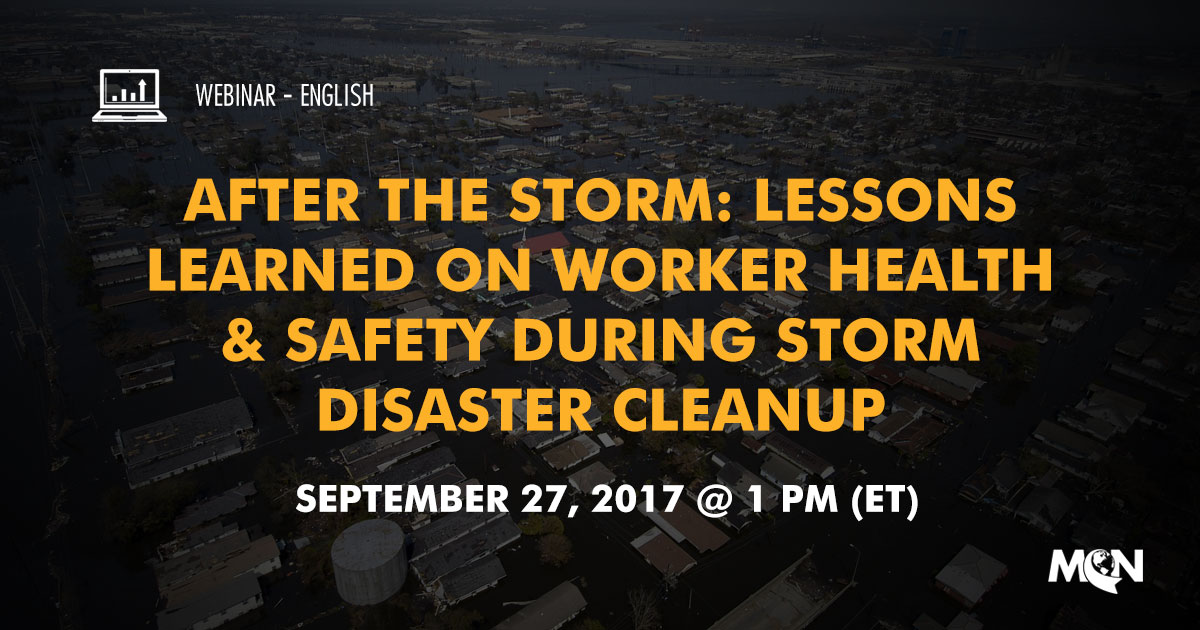
As families return to their homes in Houston as floodwaters from superstorm Harvey recede, it is a race against time. A suffocating smell already fills the living rooms, puddles remain in hallways, and spots of mold multiply quickly. Within days, the soppy lawns of neighborhoods are dump sites as workers begin gutting homes, pulling out molding drywall, damaged floors and ceilings, and wrecked furniture. In the process, these workers and many residents are exposed to mold, water contaminated with chemicals and waste, hazardous building materials, and vermin. Additional risks include working around unstable structures and carbon monoxide poisoning from generators operating in poorly ventilated spaces. Exposure to asbestos, silica and lead are also common for these workers.
Katrina, Sandy, Harvey, Irma: the names of the storms denote which communities ended up under water, but many of the stories of cleanup -- and the hazards involved -- are the same. With resilience and determination, communities will try to rebuild, but the rebuilding necessitates an immediate workforce ready for strenuous and dangerous jobs. Post-disaster recovery, cleanup, and reconstruction operations present numerous risks and dangers to workers. Many do this work without proper safety equipment or training on hazard mitigation.
In post superstorm recovery, what are the vulnerabilities workers face and what does this mean for worker safety and worker health? As clinicians and community health workers caring for this worker population, what are the key points we need to understand to care for those involved in clean up efforts and what can we do to help educate them to prevent injuries and illnesses?
This webinar brings together experience from previous natural disasters and offers resources that will help guide you. We will offer case studies to illustrate the hazards `and review ways that workers can protect themselves, including understanding their rights and responsibilities.
Watch the Webinar Recording
Download the Presentation Slides
- Identify the most critical and common hazards encountered by workers and residents engaged in post-disaster demolition and reconstruction.
- Articulate the best strategies to educate workers and others about how to prevent injuries and illness during the clean-up following hurricanes and superstorms.
- List at least three resources they can use to guide workers and residents during post-disaster demolition and reconstruction.
Presenters

Amy
Liebman
MPA, MA
Chief Program Officer, Workers, Environment and Climate
Migrant Clinicians Network
Amy K. Liebman, MPA, MA (she/her) has devoted her career to improving the safety and health of disenfranchised populations. She joined Migrant Clinicians Network (MCN) in 1999 and currently serves as the Chief Program Officer: Workers, Environment and Climate. With MCN she has established nationally recognized initiatives to improve the health and safety of immigrant workers and their families. She oversees programs ranging from integrating occupational and environmental medicine into primary care to designing worker safety interventions. She is a national leader in addressing worker safety and environmental justice through the community health worker (CHW) model. She has been a strong advocate for worker health and safety during the COVID-19 pandemic, leading programs to improve access to care and culturally contextual education for migrants and immigrants. Prior to her current position, she directed numerous environmental health and justice projects along the US-Mexico Border including an award-winning, community-based hygiene education program that reached thousands of families living without water and sewerage services. She has spearheaded policy efforts within the American Public Health Association to support the protection of agricultural workers and served on the federal advisory committee to the EPA Office of Pesticide Programs. Her programs have won several awards including the 2008 EPA Children’s Environmental Health Champion Award and the 2015 National Safety Council Research Collaboration Award. In 2011, Liebman received the Lorin Kerr Award, an APHA/Occupational Health and Safety Section honor recognizing public health professionals for their dedication and sustained efforts to improve the lives of workers. And in 2024 she was honored with the Shelley Davis Humanitarian Award for her commitment to improving farmworker health and safety. She is a past Chair of APHA’s Occupational Health and Safety. Liebman has been the principal investigator and project manager of numerous government and privately sponsored projects. She has authored articles, bilingual training manuals and other educational materials dealing with environmental and occupational health and migrants. Liebman has a master’s degree from the LBJ School of Public Affairs at the University of Texas at Austin, and a Master of Arts from the Institute of Latin American Studies at the University of Texas at Austin. Liebman has traveled throughout Mexico, Guatemala, Argentina, Chile, and Europe. She is an avid soccer fan and loves to spend time with her husband and two sons. Together they spend a lot of time outdoors.
This project is supported by the Health Resources and Services Administration (HRSA) of the U.S. Department of Health and Human Services (HHS) under cooperative agreement number U30CS09742, Technical Assistance to Community and Migrant Health Centers and Homeless for $1,094,709.00 with 0% of the total NCA project financed with non-federal sources. This information or content and conclusions are those of the author and should not be construed as the official position or policy of, nor should any endorsements be inferred by HRSA, HHS or the U.S. Government.
Continuing Education Credit (CEU)
To receive CME* or CNE credit after viewing this webinar, you must:
- Complete the Participant Evaluation associated with this webinar
- Send an email with your first and last name stating which webinar you completed to contedu@migrantclinician.org